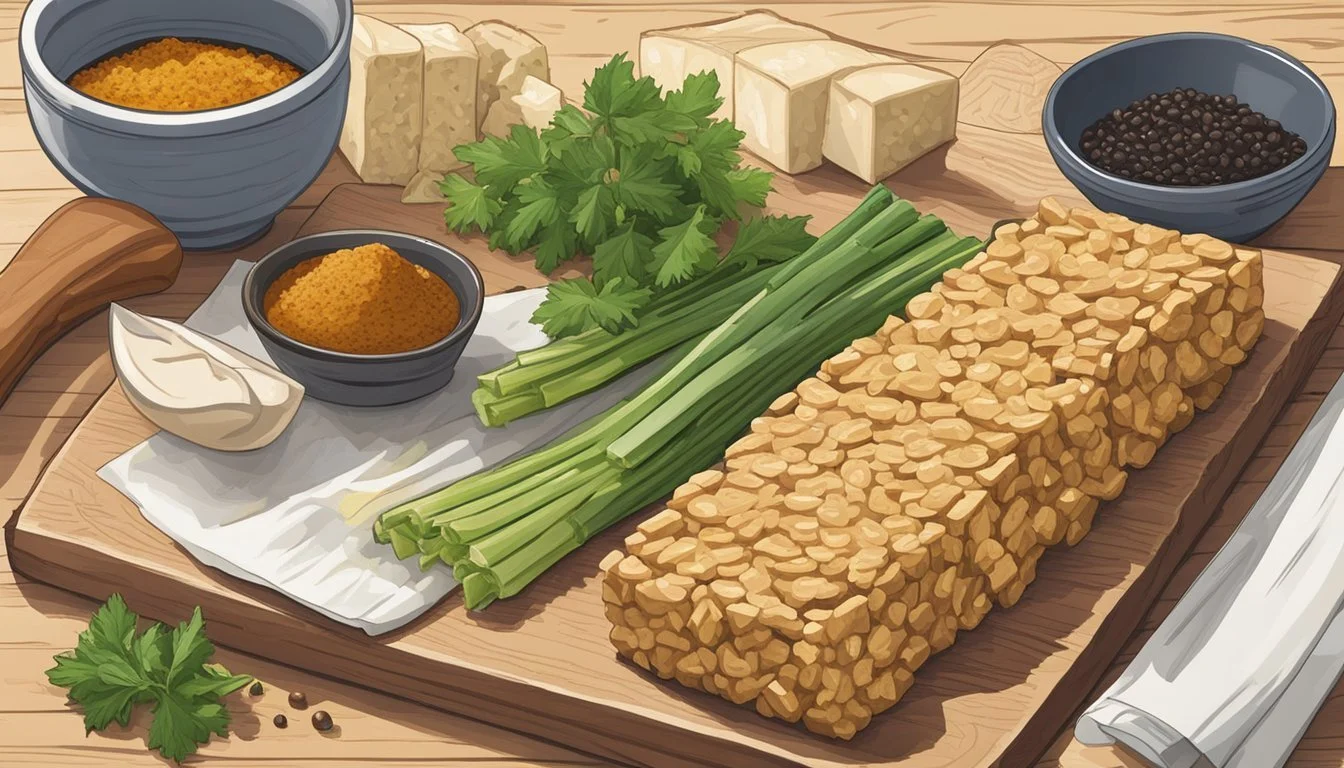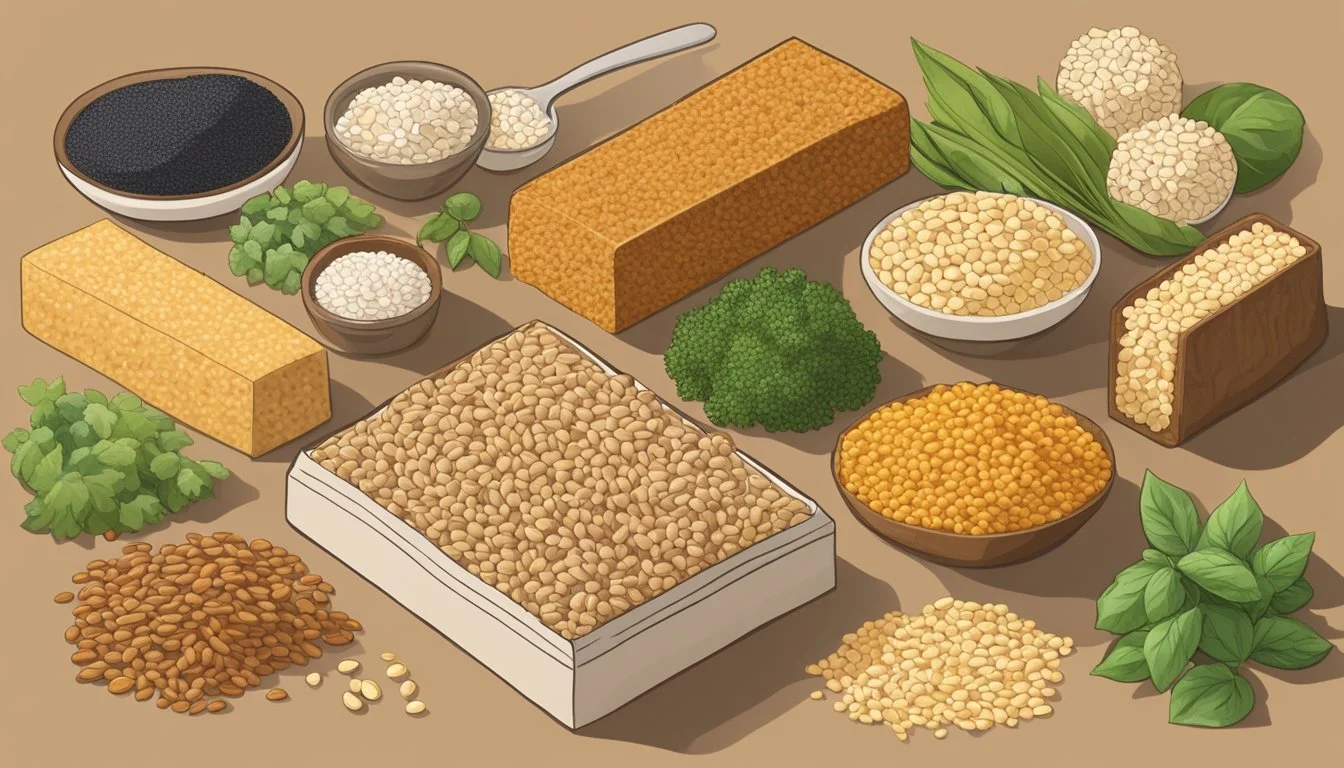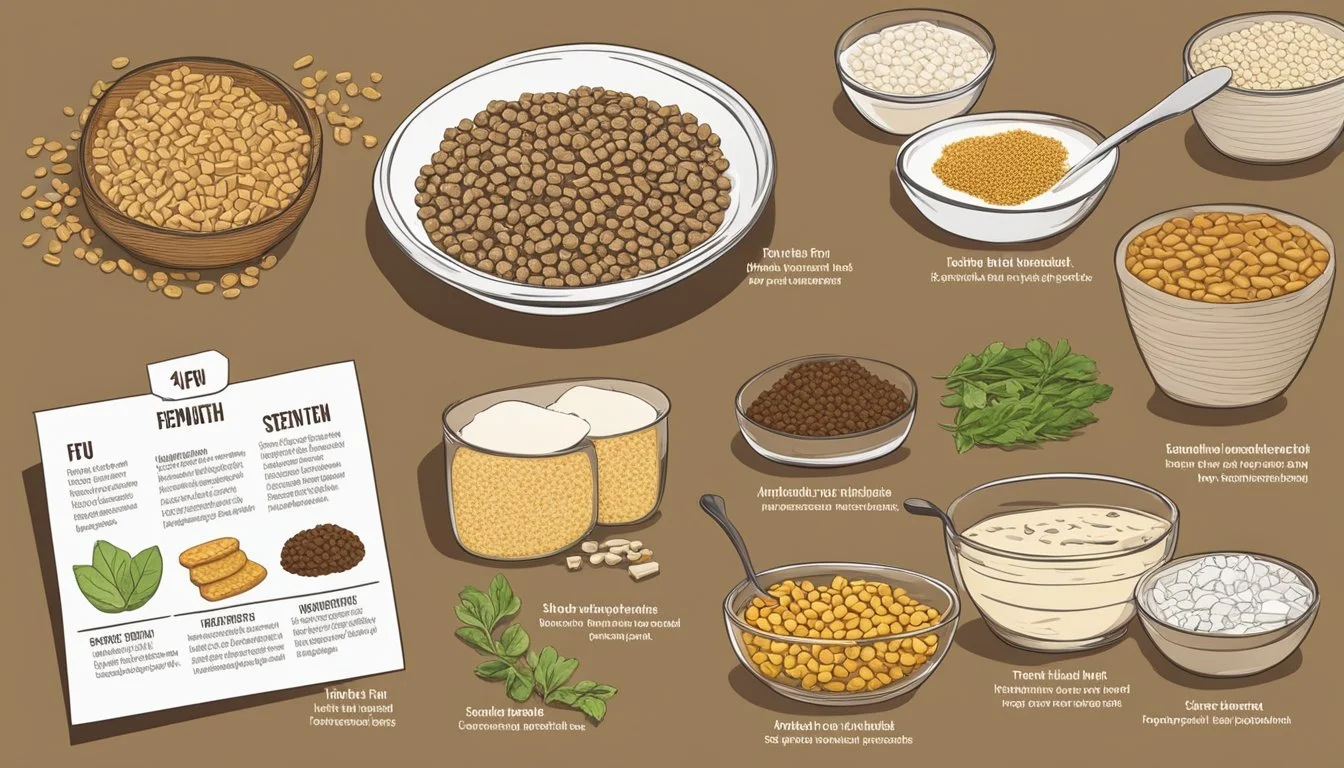Tempeh Substitutes
Top Plant-Based Alternatives for Your Diet
Tempeh, a traditional Indonesian soy product, is known for its firm texture and nutty flavor. It's a popular plant-based protein among vegetarians and vegans due to its high nutritional content, including protein, dietary fiber, and vitamins. Originating from a natural culturing and controlled fermentation process that binds soybeans into a cake form, tempeh has become a versatile ingredient in a variety of cuisines. However, due to dietary restrictions, allergies, or personal preference, some individuals seek alternatives to tempeh when cooking.
Numerous ingredients can serve as substitutes for tempeh while still providing a similar purpose in dishes. Tofu, a soy-based product like tempeh, is commonly used as a replacement due to its ability to absorb flavors and an available range in textures from silken to extra-firm. Seitan, made from wheat gluten, offers a chewier texture reminiscent of meat, making it another suitable option for those who desire a plant-based ingredient with a substantial bite. For those avoiding soy or gluten, jackfruit and mushrooms provide a suitable texture and can be seasoned to enhance flavor, aligning with a wide array of culinary uses.
Understanding the variety of tempeh substitutes available enables chefs and home cooks to adapt recipes to meet dietary needs while maintaining the desired taste and texture profiles. Each alternative brings its unique qualities to dishes, which can be leveraged to create satisfying and wholesome meals aligned with various dietary preferences.
Understanding Tempeh
Tempeh is a traditional Indonesian food known for its high protein content and health benefits, including being a whole food rich in probiotics due to the fermentation process.
What Is Tempeh?
Tempeh is a fermented soy product originating from Indonesia. It's made by a natural culturing and controlled fermentation process that binds soybeans into a cake form. This unique process results in a firm, dense texture and a nutty, earthy flavor. Unlike other soy products, tempeh is a whole food, as it is made from whole soybeans. People often use it as a meat substitute due to its substantial texture and its ability to absorb flavors from marinades and cooking.
Nutritional Profile
Tempeh is prized for its impressive nutritional profile. A reliable source of protein, it also boasts a rich content of fiber, vitamins, and minerals. The fermentation process not only enhances the food's digestibility but also produces probiotics, which are beneficial for gut health. Here's a quick look at its nutritional value:
Protein: Tempeh is a complete protein source, meaning it provides all essential amino acids.
Fiber: High in dietary fiber, tempeh supports digestive health.
Vitamins: It contains a variety of B vitamins, essential for energy metabolism.
Minerals: Rich in minerals such as calcium, magnesium, and iron.
Probiotics: The fermentation introduces beneficial bacteria that promote a healthy gut microbiome.
Given its nutrient density and health benefits, tempeh stands out as a healthy choice, particularly for those following plant-based diets.
Tempeh Substitutes Overview
In the landscape of plant-based cooking, selecting appropriate tempeh substitutes hinges on two main factors: how well they replicate the texture and flavor of tempeh and whether they're fitting for use as a meat substitute.
Criteria for Substitution
When considering tempeh alternatives, texture and flavor are paramount. Tempeh, a fermented soy product, is valued for its firm, chewy texture and a slightly nutty, earthy taste. Suitable substitutes should mimic these characteristics to ensure culinary success. The plant-based options often considered include:
Tofu: With a similar soy base, tofu's versatility allows it to take on many textures from soft to extra-firm, the latter being ideal for mimicking tempeh's heartiness.
Seitan: A wheat gluten-based substitute, seitan offers a meaty texture that can be ideal for creating chewy, protein-rich dishes.
Legumes: Lentils and chickpeas can emulate tempeh's texture when cooked properly, adding a flavorful and nutritional punch.
Textured Vegetable Protein (TVP): Made from defatted soy flour, TVP is rehydratable to a varietal texture continuum, excellent for ground tempeh applications.
Tempeh Substitute vs. Meat Substitute
While tempeh serves as an excellent meat substitute due to its high protein content and substantial mouthfeel, not all tempeh substitutes align perfectly with the characteristics of traditional meat products. It is key to distinguish between the use of tempeh alternatives as a direct meat replacement versus a tempeh stand-in. Here's a brief comparison:
As Tempeh Substitute: The intent is to closely match tempeh's unique qualities within a vegan or vegetarian context. Thus, tofu and TVP are top choices.
As Meat Substitute: The focus shifts to satisfying the broader sensory experience typically associated with meat — flavor, umami, and a meat-like texture. In this case, seitan often rises to the occasion due to its dense, chewy nature.
Recognition of the desired end product’s characteristics will guide the selection process towards the best-suited tempeh alternative.
Legume-Based Tempeh Substitutes
Tempeh, traditionally made from fermented soybeans, is known for its high protein content and versatility in cooking. For those looking for soy-free options or just a variety, other legumes offer similar nutritional benefits and can be used in a range of dishes.
Tofu Varieties
Tofu, like tempeh, is derived from soybeans but presents a different texture and variety of forms. Extra-firm tofu holds its shape well, making it suitable for grilling and frying, similar to how one might cook tempeh. On the other hand, silken tofu has a softer consistency, which doesn't mimic tempeh's chewiness but can still be incorporated into plant-based dishes for its protein content.
Extra-firm tofu: Best for savory dishes where a hearty texture is desired.
Silken tofu: Suitable for creamy and blended preparations due to its softer texture.
Chickpeas and Beans
Chickpeas and other beans are outstanding legume substitutes that provide a robust amount of plant-based protein. Their versatility allows them to be transformed into patties, used in salads, or mashed for spreads. Beans closely replicate the feeling of satiety and nutrient profile that tempeh offers, all while being soy-free.
Chickpeas: Excellent for falafels and hummus, offering both protein and fiber.
Beans: Variety of beans like black beans and kidney beans work well in plant-based burgers and stews.
Lentils
Lentils are a soy-free substitute known for their impressive protein content and ease of cooking. They do not mimic the exact texture of tempeh but can provide a similar nutritional value. Lentils are highly adaptable and can be used whole in salads, mashed in vegan loafs, or pureed into soups.
Cooking Lentils: They can be seasoned and cooked to enhance their flavor, making them a satisfying stand-in for tempeh in many recipes.
Vegetable Alternatives
When exploring plant-based alternatives to tempeh, certain vegetables stand out for their ability to mimic tempeh's firm texture and absorb flavors in dishes. These alternatives offer a variety of textures and tastes suitable for a range of recipes, from sandwiches to stews.
Jackfruit
Jackfruit has a remarkable ability to take on a meaty texture when cooked, making it a popular substitute for pulled pork. Its fibrous consistency can add heartiness to a variety of dishes. When young and unripe, jackfruit has a neutral flavor, serving as an ideal canvas for savory spices and seasonings.
Mushrooms
Mushrooms, particularly portobello mushrooms, are renowned for their rich umami flavor and firm texture. They can be used whole, sliced, or diced in cooking, providing a meaty chew reminiscent of tempeh. Portobellos work exceptionally well in recipes like veggie burgers and stews where a substantial texture is desired.
Cauliflower
Cauliflower's neutral flavor and versatile texture make it a common tempeh substitute in various dishes. It can be chopped finely to resemble crumbled tempeh or left in larger florets for a more substantial bite. Whether roasted, stir-fried, or steamed, cauliflower adapts well to a plethora of culinary applications.
Eggplant
Eggplant is a vegetable with a spongy texture that allows it to soak up flavors, much like tempeh. When sliced and cooked, eggplant can develop a firm, meaty texture. It's often used in sandwiches, stir-fries, and as the base for a veggie burger, providing a satisfying substitute for those seeking a plant-based option.
Grain and Seed Substitutes
When looking for tempeh substitutes, grains and seeds offer a nutritious and versatile alternative. They are particularly appreciated in vegetarian and vegan diets for their high protein content and can be masterfully incorporated into various dishes, such as burgers and salads.
Quinoa
Quinoa, a gluten-free seed that cooks like a grain, is an excellent substitute for tempeh. Its texture is somewhat similar to tempeh when cooked, making it a suitable addition to recipes that require a hearty component. Quinoa is high in protein and also offers a significant amount of iron, which can contribute to a balanced diet. It works particularly well in:
Salads: Adds a protein-rich, nutty component
Burgers: Can be used to create a firm, satisfying patty
Brown Rice
Another whole food substitute is brown rice, which offers a chewy texture that can mimic the bite of tempeh. Though not as high in protein as quinoa or tempeh, it is still a good source of nutrients and can act as a solid base in many dishes. Brown rice is especially effective when used in:
Stuffed vegetables: Provides a texturally pleasing bulk
Casseroles: Absorbs flavors while maintaining its form
Seeds
Seeds, such as sunflower, pumpkin, or hemp seeds, are nutritional powerhouses, often chosen for their health benefits and for being naturally gluten-free. They deliver not only on texture but also on protein content. When used in dishes, seeds can impart a satisfying crunch and are particularly useful as a topping or mixed into recipes where a nutty taste and extra protein are desired. Examples include:
Salads: For a protein boost and added crunch
Granolas or Parfaits: Provide texture and are substantial in protein content
Processed Plant Proteins
Processed plant proteins offer meat-like textures and flavors that can be easily incorporated into various recipes. They are known for their high-protein content and versatility in vegan and vegetarian diets.
Seitan
Seitan, made from wheat gluten, stands out for its chewy texture and ability to absorb flavors. It's an excellent base for vegan burgers, marinades, and stir-fries due to its versatility. Protein content is one of seitan's strong suits, making it a popular meat alternative that can be grilled or cooked in multiple ways.
Textured Vegetable Protein (TVP)
Textured Vegetable Protein (TVP) is a high-protein, dehydrated product made from soy flour. Its granular consistency works well to simulate minced meat, providing a protein boost for dishes. TVP rehydrates quickly, adopting the taste of whatever marinades and seasonings it's cooked with, enhancing its application in a variety of recipes.
Tofu-Based Products
Tofu, derived from soybeans, serves as a base for various processed products. Tofu-based items range from tofu burgers to mock meats. They come in different firmness levels, which allows them to be used in a wide array of culinary applications, from frying to baking. Although tofu itself is more subtle in flavor, tofu-based products are designed to mimic specific meats and can offer a robust taste experience when properly seasoned.
Cooking Techniques and Tips
When substituting tempeh in recipes, one must consider marinating and seasoning, preparing the texture appropriately, and adjusting cooking temperatures and methods. These factors will ensure that the alternative ingredients deliver the desired savory and earthy flavors typically provided by tempeh.
Marinating and Seasoning
Substitutes like tofu and seitan absorb flavors well, making them ideal candidates for marinating. For a flavor akin to tempeh, one can use a marinade with soy sauce, garlic, and a mix of spices to impart a nutty and seasoned profile. Marinating time can greatly influence the flavor depth - longer periods allow for a more robust taste.
Suggested Marinades:
Soy sauce, garlic, ginger, and maple syrup for a sweet and savory note.
Apple cider vinegar, liquid smoke, and paprika for a smoky and tangy flavor.
Texture and Prep
Preparing the texture of substitutes is crucial to mimicking tempeh’s firmness. For instance, pressing tofu before marinating removes excess moisture, creating a denser texture suitable for various cooking techniques. When prepping seitan, one should knead the dough to develop gluten, which provides a chewy texture similar to tempeh.
Preparation Tips:
Press tofu for at least 30 minutes.
Knead seitan dough for 3-5 minutes.
Cooking Temperature and Methods
Each substitute requires specific cooking temperatures and methods to achieve the best results. Tofu benefits from frying or baking at medium heat to maintain its structure, while seitan can withstand high-heat cooking methods like grilling. It’s important to adjust the temperature based on thickness and desired crispiness.
Ideal Cooking Methods:
Tofu: 350-375°F for baking, medium heat for frying.
Seitan: High heat for grilling or sautéing.
By considering these aspects of seasoning, preparation, and cooking, one can successfully incorporate tempeh substitutes into their recipes without compromising on texture and flavor.
Health and Nutritional Considerations
When selecting substitutes for tempeh, it's important to consider both the dietary requirements and the health benefits they may offer. Different substitutes can provide varying levels of protein, fiber, vitamins, and minerals, essential for a balanced diet.
Dietary Requirements
Prospective tempeh substitutes cater to a range of dietary needs. For individuals seeking vegan or vegetarian options, substitutes like seitan and tofu often serve as suitable replacements, supplying ample protein content. However, seitan is made from wheat gluten and is not suitable for those on a gluten-free diet. On the other hand, for those avoiding soy products, options like lentils and mushrooms are soy-free alternatives that still provide beneficial nutrients. Aspects to consider include:
Protein Content: Vital for muscle repair and growth. Seitan and tofu are high in protein, much like tempeh.
Vitamin and Mineral Content: Important for overall health. Lentils, for example, are a good source of iron and fiber.
Special Diets: Gluten-free and soy-free options should be considered for those with allergies or sensitivities.
Health Benefits
Tempeh substitutes not only fulfill specific dietary needs but also offer various health benefits. Foods like tofu, textured vegetable protein (TVP), and mushrooms are not just protein-rich; they also contain other essential nutrients:
Fiber: Key for digestive health, found in options like TVP and lentils.
Iron: Crucial for blood health, with lentils being a well-known source.
Vitamins and Minerals: Necessary for various body functions, found in various amounts across all substitutes. Mushrooms, for example, can be a source of vitamin D.
Incorporating these substitutes into a diet can contribute to overall well-being while ensuring that meals are nutritive and align with one's dietary restrictions.
Finding Tempeh Substitutes
When looking for alternatives to tempeh, consumers should consider factors like taste, texture, and nutritional content. Substitutes should be versatile enough to fit into a variety of dishes, from tacos and burgers to salads and sandwiches.
Grocery Stores and Health Food Shopping
Consumers can find a range of tempeh substitutes at grocery stores and health food stores. Plant-based proteins that are commonly available include:
Tofu: A versatile ingredient available in soft to extra-firm textures, suitable for a range of recipes.
Seitan: Often found as canned or raw in the refrigerated section, seitan is a wheat-based protein that mimics the firmness of tempeh.
Textured Vegetable Protein (TVP): Available as dried chunks or granules, great for a quick tempeh replacement, especially in recipes requiring crumbled protein like tacos.
When shopping for tempeh substitutes, one should look for products in the refrigerated section of health food stores, as fresh and whole-food options typically offer better flavor and nutrient profiles. Asian and Indonesian sections may also offer unique plant-based options that work well in traditional and contemporary recipes.
Cooking at Home and Recipe Ideas
In the kitchen, individuals can use tempeh substitutes to create satiating, plant-based meals. Some recipe ideas include:
Tofu: Marinade and bake for a crispy addition to salads or mash for burgers.
Seitan: Season, grill, or sauté for sandwiches; it's especially good when seeking a chewier texture.
Textured Vegetable Protein: Rehydrate with vegetable broth and use as a ground meat substitute in tacos.
One can season these substitutes to taste, reflecting the versatility tempeh is known for, especially in Indonesian food. For the best culinary experience, one should choose a substitute that matches the desired flavor profile and texture of the dish they are preparing.









